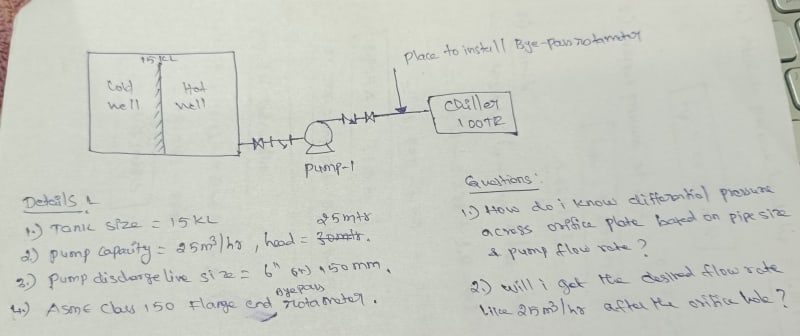Asisraja D
Mechanical
Hello professionals
This forum has helped me a lot and again i thank you all for helping me in this.
we have planned to install a bye-pass rotameter in our chiller piping (Hot well to chiller).
The problem arises when we talk to vendor about bye-pass rotameter he introduced us about Differential pressure across the orifice plate.
As he told us there is no possibility of direct fitting of flange type bye-pass rotameter in our system because in vendor's catalogue for 6" pipes the minimum flow should be 136 m3/hr then only we can get 50 inches of water column as differential pressure across the orifice plate. i am totally new to this installation technique and currently we have no options to change the pump capacity. we have pump capacity of 25 m3/hr and 25 meter of head. i have given the vendor's data and our piping data in the attached file. i have some doubts on this and i will ask them below:
1)if the pressure drop across the orifice increases does it affect the desired pump flow rate ?
2)if differential pressure is based on orifice plate diameter then how can i decide the orifice plate diameter ?
3)is there any alternative way to reach that differential pressure as per vendor's catalogue in our 6" piping line ?
i know your time is priceless and i am sorry if i made any mistake in this concept, please help me when you are free to read this.
Thank you all.
This forum has helped me a lot and again i thank you all for helping me in this.
we have planned to install a bye-pass rotameter in our chiller piping (Hot well to chiller).
The problem arises when we talk to vendor about bye-pass rotameter he introduced us about Differential pressure across the orifice plate.
As he told us there is no possibility of direct fitting of flange type bye-pass rotameter in our system because in vendor's catalogue for 6" pipes the minimum flow should be 136 m3/hr then only we can get 50 inches of water column as differential pressure across the orifice plate. i am totally new to this installation technique and currently we have no options to change the pump capacity. we have pump capacity of 25 m3/hr and 25 meter of head. i have given the vendor's data and our piping data in the attached file. i have some doubts on this and i will ask them below:
1)if the pressure drop across the orifice increases does it affect the desired pump flow rate ?
2)if differential pressure is based on orifice plate diameter then how can i decide the orifice plate diameter ?
3)is there any alternative way to reach that differential pressure as per vendor's catalogue in our 6" piping line ?
i know your time is priceless and i am sorry if i made any mistake in this concept, please help me when you are free to read this.
Thank you all.

